Writer: Michael Morain
Photographer: Duane Tinkey
Decades ago, before dating apps enabled people to share their personal profiles and proclivities, gay and bisexual men established a “hanky code” to signal what they were into. A purple handkerchief peeking out of a back pocket might hint at a preference for piercings. An orange one could indicate “anything goes.”
History suggests the custom began in the 19th century out West, where cowboys, miners and railroad workers often wore bandanas while they worked. In California, after the Gold Rush, a shortage of women at dances may have prompted some men to wear a blue bandana when they danced traditionally “male” roles and a red one when they danced “female” roles. The exact origins are a little murky, but by the 1960s and ’70s, the hanky code had become much more “colorful” — in every sense of the word.
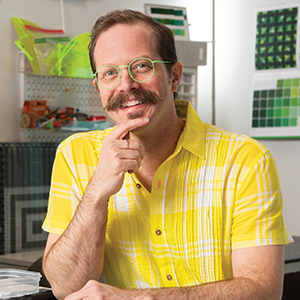
When the local artist Ben Millett recently found himself with a stash of fabric remnants from a previous project, he decided to assemble them into a quilt that celebrated that history. The resulting work, in which a rainbow of scraps bursts across a white field, is one of about two dozen bold and beautifully intricate quilts Millett plans to display in his upcoming solo show at the Des Moines Art Center during this year’s Iowa Artists exhibition, July 26 through Nov. 2. His quilts add new layers to an art form that is as Iowan as a barn mural or a county fair.
“As far as I know, this is the Des Moines Art Center’s first all-quilt show,” said longtime curator Laura Burkhalter, who first spotted Millett’s work a few years ago at the Polk County Heritage Gallery. His big green quilt inspired by the Emerald City in “The Wizard of Oz” caught her eye “for the way it blended influences and meaning,” she said. “I was just absolutely blown away.”
Burkhalter started following Millett’s work on Instagram and was impressed by how it stitched together so many ideas: color theory, art history, traditional crafts, social justice, gender politics and more.
When she eventually invited him to display his work at the Art Center, he was surprised. “When I got that first email, I thought, ‘Wait, no. I don’t believe it,’” he recalled. “It was amazing.”
Millett rents space at Mainframe Studios, where he stores all sorts of threads and fabric in tidy bins around a Handi Quilter Moxie XL, a long-arm sewing machine that can accommodate projects up to 8 feet long. When he’s not toiling away in the studio, he works as a product manager for Corteva, where he helps develop software for the sales team. He has a Ph.D. in plant pathology and a background in website design.
So yes, he is very smart. And crafty. He grew up near St. Louis and learned how to knit from his grandmother. Some of his early projects were baby blankets for his nieces and nephews, but he couldn’t keep up with the baby boom. “I needed something faster,” he said.
When his grandmother could no longer make quilts for newlyweds in the family, he offered to carry on the tradition. “I really enjoyed cutting up the fabric and figuring out where all the blocks were supposed to go,” he said. In that way, it’s like web design, but there’s a bonus, “a physical object that isn’t some digital thing.”
After the one-man quilting machine cranked out quilts for various family members and friends, he shifted his focus a few years ago to art quilts designed to hang on a wall rather than to cover a bed. They’re less functional, he said, “but there’s a phrase: ‘Beauty is useful.’”
Some of his quilts are experiments with colors and shapes. But most carry some sort of symbolism, he said, “whether it’s a subtle message or a hit-you-over-the-head message that says ‘Yes, I am gay.’” On one of his quilted shirts, gold thread scribbles across a black background in a pattern that seems abstract until you spot the repeated letters G-A-Y. Inside, the lining bursts with rainbows. He made it after Florida passed its so-called “Don’t Say Gay” law, which limits classroom instruction on sexual orientation and gender identity.
Other quilts riff on the evolution of Gilbert Baker’s original 1978 Pride flag, with its six rainbow stripes, into the current versions that honor transgender people and LGBTQ people of color. Another series traces Millett’s own journey toward coming out at age 35, with shades of green — his favorite — that gradually progress from dark to bright.
But even with its contemporary themes, his work embroiders traditions that stretch back centuries, with patterns like “Courthouse Steps,” “Log Cabin” and “Missouri Puzzle.” A common thread ties his work to his grandmother’s and, most likely, her own grandmother’s, too.
“He clearly thinks about every detail,” Burkhalter said. His work “speaks to that mindfulness. It’s about preserving things but telling the story in his own way.”
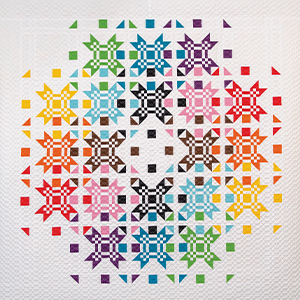
“Progress Pride Stars” (2023)
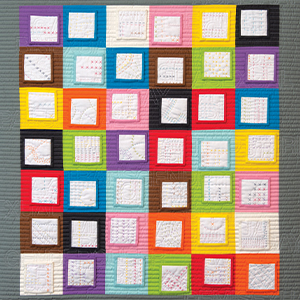
“Progress Pride Tiny Quilt Sketches” (2023)
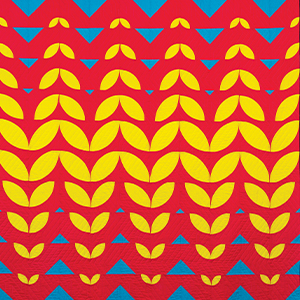
“Phosphorific (Tri-Color)” (2020)
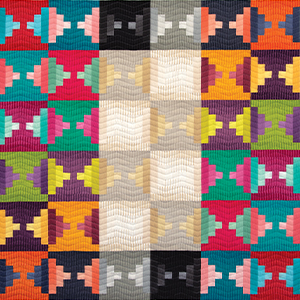
“Solid Steps” (2021)
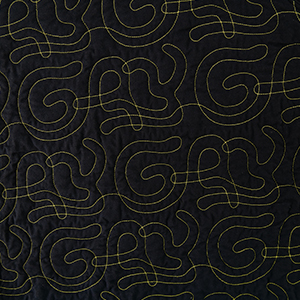
Say GAY!” (2023)
Designs by Ben Millett; long-arm quilting by Kristen Lee.







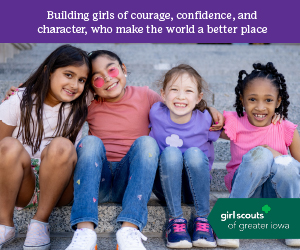




Show Comments (0)